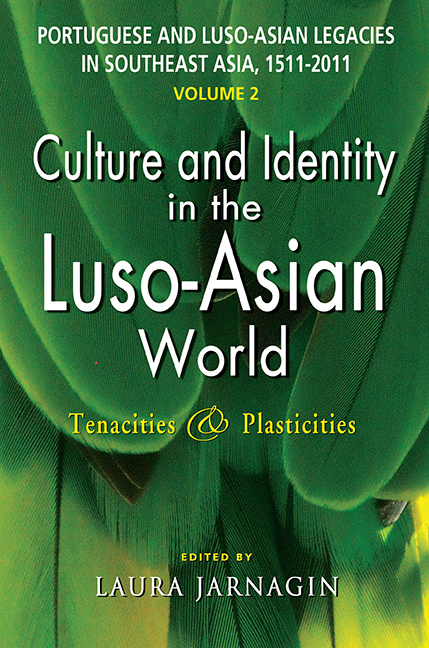 Portuguese and Luso-Asian Legacies in Southeast Asia, 1511-2011, vol. 2
Portuguese and Luso-Asian Legacies in Southeast Asia, 1511-2011, vol. 2 Book contents
- Frontmatter
- Contents
- List of Figures and Tables
- Preface
- List of Contributors
- Glossary
- Introduction: The Qualitative Properties of Cultures and Identities
- Part One Crafting Identity in the Luso-Asian World
- Part Two Cultural Components: Language, Architecture and Music
- 5 The Creole-Portuguese Language of Malacca: A Delicate Ecology
- 6 Oral Traditions of the Luso-Asian Communities: Local, Regional and Continental
- 7 Verb Markings in Makista: Continuity/Discontinuity and Accommodation
- 8 From European-Asian Conflict to Cultural Heritage: Identification of Portuguese and Spanish Forts on Ternate and Tidore Islands
- 9 The Influence of Portuguese Musical Culture in Southeast Asia in the Sixteenth and Seventeenth Centuries
- Part Three Adversity and Accommodation
- Appendix: Maps
- Bibliography
- Index
- Titles in the Nalanda-Sriwijaya Studies Centre Series
7 - Verb Markings in Makista: Continuity/Discontinuity and Accommodation
from Part Two - Cultural Components: Language, Architecture and Music
Published online by Cambridge University Press: 21 October 2015
- Frontmatter
- Contents
- List of Figures and Tables
- Preface
- List of Contributors
- Glossary
- Introduction: The Qualitative Properties of Cultures and Identities
- Part One Crafting Identity in the Luso-Asian World
- Part Two Cultural Components: Language, Architecture and Music
- 5 The Creole-Portuguese Language of Malacca: A Delicate Ecology
- 6 Oral Traditions of the Luso-Asian Communities: Local, Regional and Continental
- 7 Verb Markings in Makista: Continuity/Discontinuity and Accommodation
- 8 From European-Asian Conflict to Cultural Heritage: Identification of Portuguese and Spanish Forts on Ternate and Tidore Islands
- 9 The Influence of Portuguese Musical Culture in Southeast Asia in the Sixteenth and Seventeenth Centuries
- Part Three Adversity and Accommodation
- Appendix: Maps
- Bibliography
- Index
- Titles in the Nalanda-Sriwijaya Studies Centre Series
Summary
Makista (PCMac), the Portuguese-based Creole of Macao, came into existence in the wake of the settlement of the Portuguese in Macao in the mid-sixteenth century. As is common to Creole languages created in the sequence of the European maritime expansion, the raison d’être behind their formation lies in the sudden and often forced confluence and coexistence of speakers from diverse linguistic and ethnic backgrounds and, thus, the need for a common linguistic code. Given certain demographic, linguistic and historical constraints, such languages share in common the co-existence of lexical, morphologic and syntactic traits from the different contributing languages (specific to each Creole), in varying degrees. From the time Macao was occupied on a permanent basis by the Portuguese from 1557 onwards, the main linguistic contributor to the formation of Makista was Kristang (PCMal), the Portuguese-based Creole of Malacca, and thus considered this Creole's substrate. Besides Luso-Malay families, we find references to Malays in Macao by 1565 who would have spoken Kristang.
In the case of the formation of Creoles, the co-existence of several variants, from the different languages in contact for a common linguistic function, has been described as a “feature pool”. From this pool of joint features, some variants will be dropped and others selected, and many times modified by the speakers of the emerging language. In the case of PCMac, PCMal, as well as other Asian varieties of Portuguese-based pidgins and non-standard Portuguese, standard Portuguese, Cantonese and Hokkien came together in Macao and formed the “feature pool” of this Creole. The linguistic items ultimately selected and transposed to the emerging Creole may either retain their exact original functions, narrow or widen them.
This chapter takes a comparative look at the frequent aspectual marker in PCMac, ja. A marker shared in common with PCMal, albeit in the latter, as with the other two verbal markers they share in common (ta, logu), the use is much more restrictive.
- Type
- Chapter
- Information
- Portuguese and Luso-Asian Legacies in Southeast Asia, 1511-2011, vol. 2Culture and Identity in the Luso-Asian World: Tenacities & Plasticities, pp. 167 - 178Publisher: ISEAS–Yusof Ishak InstitutePrint publication year: 2012


